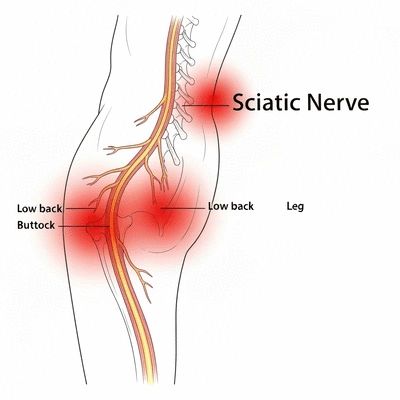Anatomy & Function of the Sciatic Nerve
- •Spinal Roots: Originates from L4 to S3.
- •Pathways: Travels through buttocks & down legs.
- •Functions: Controls movement & sensation in lower limbs.

What if a simple change in your daily routine could significantly alleviate your pain? Understanding and managing sciatica is crucial for reclaiming your quality of life. With insights from experts like Dr. Samuel N. Hartley, we can explore effective strategies for relief.
Delve into the key aspects of sciatica, from its anatomical origins and common triggers to effective long-term management strategies, presented in a clear, comparative overview.
Understanding sciatica can feel overwhelming, especially when it disrupts your daily life. Have you ever found yourself wincing with pain after a long day of sitting? You’re not alone. Sciatica refers to pain that travels along the sciatic nerve, which is the longest nerve in the body, and it can significantly impact your quality of life.
Many individuals experience a range of symptoms, from sharp pain in the lower back to numbness and tingling in the legs. It’s crucial to recognize these signs early as they can help guide your journey toward recovery. At Sciatica Solutions, we aim to demystify this condition and empower you with knowledge!

Sciatica is not just a medical term; it represents a range of experiences for those affected by it. Typically, it arises when the sciatic nerve is compressed or irritated, leading to discomfort that can radiate from the lower back down through the leg. For a deeper dive into its characteristics, the Mayo Clinic provides comprehensive insights into sciatica's symptoms and causes. Understanding how sciatica manifests is vital for effective management.
These symptoms can make everyday activities, such as walking, bending, or even sitting, challenging. By recognizing these challenges, you can work towards developing strategies to cope, ensuring you regain control over your daily routine.
The sciatic nerve is a remarkable structure, branching from the lower spine and extending down each leg. It’s responsible for transmitting signals between the brain and various parts of the lower body. Understanding its anatomy can shed light on why issues in this nerve can lead to such profound discomfort. For a detailed anatomical and physiological overview, the National Center for Biotechnology Information offers extensive information on the sciatic nerve.
To appreciate its significance, consider the following components:
When the sciatic nerve is compromised, it can result in a cascade of symptoms that affect your overall well-being. Understanding this anatomy can empower you to take proactive steps in managing your sciatica effectively.
Identifying the various causes of sciatica is a crucial step in managing this condition. Often, the root cause can be traced back to specific triggers that irritate or compress the sciatic nerve. Let’s explore some common culprits together!
By knowing these triggers, you can begin to identify potential patterns in your own experience. Have you noticed certain activities that seem to exacerbate your symptoms? Keeping track of these can provide valuable insights as you work towards developing a tailored management plan.
Did you know? Incorporating regular stretching and strengthening exercises into your daily routine can significantly alleviate sciatica pain? Simple movements like hamstring stretches and pelvic tilts can enhance flexibility and support your spine, ultimately leading to long-term relief. Consider setting aside a few minutes each day to focus on these exercises!
Managing sciatica doesn’t just stop with treatment; it's essential to adopt long-term strategies to prevent flare-ups and reduce the risk of future pain. At Sciatica Solutions, I emphasize the importance of proactive measures. Together, we can explore lifestyle changes that can make a significant difference in your journey toward relief.
First, let’s discuss prevention tips. Making small adjustments in your daily routine can lead to substantial benefits. Here are some effective strategies to consider:
These lifestyle changes not only help to minimize the risk of sciatica but also enhance your overall well-being. Have you tried making any of these adjustments yet? Let’s see how they might fit into your daily life!

Next, let’s dive into the critical role of posture and ergonomics in managing sciatica. Poor posture can contribute to increased pressure on the sciatic nerve, leading to discomfort. By being mindful of your posture, you can alleviate strain on your back. Here are a few quick tips:
Being aware of how you position your body throughout the day can significantly impact your pain levels. Remember, small adjustments can lead to lasting changes!
Engaging in exercises specifically designed for sciatica relief is vital for long-term management. Regular stretching and strengthening not only alleviate pain but also support the spine. Here’s a list of recommended exercises that you can incorporate into your routine:
Have you considered working with a physiotherapist? A professional can tailor exercises to fit your specific needs, ensuring that you’re engaging in safe and effective movements.
Lastly, it’s essential to recognize the risk factors that may contribute to your sciatica. Understanding these factors can empower you to make informed decisions. Key risk factors include:
By identifying these risks, you can take proactive steps toward prevention. It’s all about being aware and making adjustments that support your health!
Here is a quick recap of the important points discussed in the article:
Smoking's Impact on Sciatica Pain

Quitting smoking can be a transformative decision for your health, especially if you're battling sci
Smoking's Impact on Sciatica Pain
Yoga for Sciatic Nerve Relief
When to Treat Your Sciatica
Preventing Sciatica from Heavy Lifting
Selecting a Back Brace for Sciatica